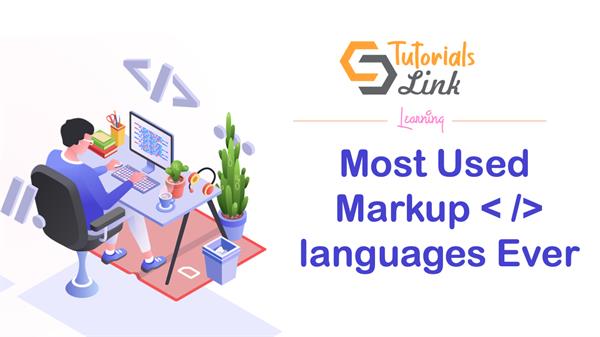Most Used Markup languages Ever
Markup languages are the bricks and mortar of the web designing where it all started when websites were just static pages with text and some formatting. Originating from typesetting process used in early printing presses, these languages have been used to annotate the text of the site, dictating
Both the architecture of a site and the display of text. While markup languages are a part of the past, that hasn't made them obsolete. I fact they have remained a core of development and its future as well.
Everything you see on the web is a combination of markup (text), CSS (design) and from -end script (interactivity), and that markup is what creates a site’s foundation. HTML is the main markup
for web pages, or just about anything displayed in a browser, which explains why it’s still incredibly relevant, and why so many developers know it.
Here’ s a look at how these languages fit into the fabric of web development as a whole, what makes them different, and a few of the most notable in use.
Information about how markup language differ from programming languages
The currently of markup languages is text. It controls how text is displayed, structured, and organized. While programming language tells data and databases on how to behave, HTML structure data.
It works through annotation
AT its most basic, it is peppered throughout the text in the form of annotation, which tells software, or a browser, how to display that text. If you’ve ever seen HTML in the raw, you’ve probably noticed “tags’’-- descriptive commands embedded in the text, set between opening and closing brackets. These tags indicate that whatever is inside those brackets is not text, but something
for the browser to process – making text bold or hyperlinked or breaking a paragraph.
There are two types of markup:-descriptive procedural. Procedural markup handles the physical treatment of text-- embedded tags that give program instructions for how to display text. Descriptive markup, like HTML, labels part of a document into logical, structural parts-- the headline start here end here. And end for example, “The door is red’’ is descriptive, while “open the door’’ is procedural. Markup is still not programming – it’s information that the browser is programmed to interpret.
here’s a look at the Four most popular languages and the basics of how they function:
1) HTML(HYPERTEXT MARKUP LANGUAGE)
HTML (hypertext markup language) was the first internet – base language. This descriptive mark up language is the core markup for all webpages or most anything displayed in the browser, which is why it remains such a core skill for all developers. HTML has evolved to its most recent
version, HTML5, which adds more features than the previous version can now define the way videos, images, and text look.
Once a website’s HTML document is created other aspect can be embedded into the markup ---e.g., a Javascript program can be embedded within HTML to add interactivity to the site, and cascading style sheet (CSS) can be linked to the HTML file to control all of the design aspects. In this way, it’ the backbone of the site.
2) XML (EXTENSIBLE MARKUP LANGUAGE)
XML is another descriptive markup language that functions like a complement to HTML. Its core difference is that it describes an element of data while HTML displays that data. For example in coding an online menu for a restaurant. XML tags could organize elements of each dish the item name, description and price HTML tags would control how these elements were displayed the item name in bold text, the description in italics, and the price in red.
XML had a second coming as a major building block of AJAX (asynchronous, JavaScript+XML) the groundbreaking technology that allows websites and applications like Gmail to load or update specifies elements without refreshing an entire page. An XMLHTTP Request is a key to how AJAX works its a core unit measure when interacting with an XML file on a database, fetching specific information.
3) UML (UNIFIED MODELING LANGUAGE)
UML stands for Unified Modeling Language which is used to specify, visualize, construct and document artifacts of a software system. UML has been extended to a larger set of design documentation and been found useful in any context. UML is a powerful tool that can greatly improve the quality of your system analysis and designs. The UML is important because it can help software developers communicate.
4) WML (WIRELESS MARKUP LANGUAGE)
WML stands for Wireless Markup Language which is based on XML it is a language that allows the text portions of web pages to be presented on cellular telephones and personal digital access.
WML is a part of the wireless applications protocol that is being proposed by several vendors to standard bodies.





